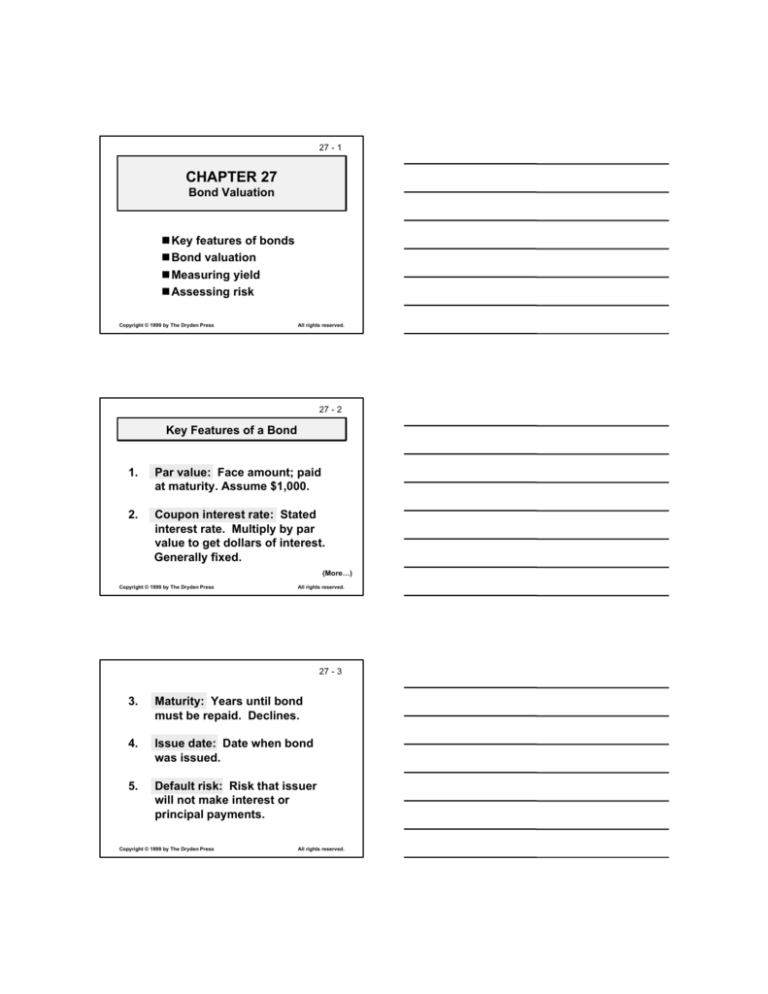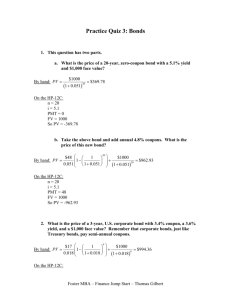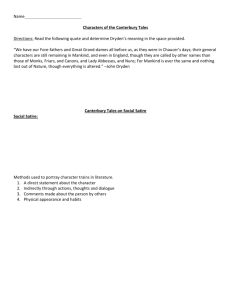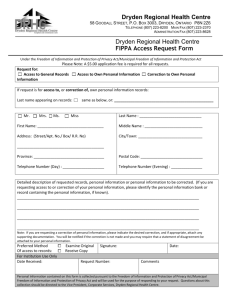
27 - 1
CHAPTER 27
Bond Valuation
nKey features of bonds
nBond valuation
nMeasuring yield
nAssessing risk
Copyright © 1999 by The Dryden Press
All rights reserved.
27 - 2
Key Features of a Bond
1.
Par value: Face amount; paid
at maturity. Assume $1,000.
2.
Coupon interest rate: Stated
interest rate. Multiply by par
value to get dollars of interest.
Generally fixed.
(More…)
Copyright © 1999 by The Dryden Press
All rights reserved.
27 - 3
3.
Maturity: Years until bond
must be repaid. Declines.
4.
Issue date: Date when bond
was issued.
5.
Default risk: Risk that issuer
will not make interest or
principal payments.
Copyright © 1999 by The Dryden Press
All rights reserved.
27 - 4
How does adding a call provision
affect a bond?
nIssuer can refund if rates decline.
That helps the issuer but hurts the
investor.
nTherefore, borrowers are willing to
pay more, and lenders require more,
on callable bonds.
nMost bonds have a deferred call and
a declining call premium.
Copyright © 1999 by The Dryden Press
All rights reserved.
27 - 5
What’s a sinking fund?
nProvision to pay off a loan over its
life rather than all at maturity.
nSimilar to amortization on a term
loan.
nReduces risk to investor, shortens
average maturity.
nBut not good for investors if rates
decline after issuance.
Copyright © 1999 by The Dryden Press
All rights reserved.
27 - 6
Sinking funds are generally handled
in 2 ways
1. Call x% at par per year for sinking
fund purposes.
2. Buy bonds on open market.
Company would call if kd is below the
coupon rate and bond sells at a
premium. Use open market purchase
if kd is above coupon rate and bond
sells at a discount.
Copyright © 1999 by The Dryden Press
All rights reserved.
27 - 7
Financial Asset Valuation
0
1
2
k
Value
CF1
PV =
n
...
CF1
+
CF2
CF2
(1+ k)1 (1+ k)2
CFn
+ ... +
Copyright © 1999 by The Dryden Press
CFn
(1+ k)n
.
All rights reserved.
27 - 8
nThe discount rate (ki) is the
opportunity cost of capital, i.e.,
the rate that could be earned on
alternative investments of equal
risk.
ki = k* + IP + LP + MRP + DRP
for debt securities.
Copyright © 1999 by The Dryden Press
All rights reserved.
27 - 9
What’s the value of a 10-year, 10%
coupon bond if kd = 10%?
0
1
2
10%
V=?
VB =
10
...
100
$100
(1 + k d )
1
+ ... +
= $90.91 +
= $1,000.
100 + 1,000
100
$100
(1+ k d )
10
+
$1,000
(1+ k d )
10
. . . + $38.55 + $385.54
Copyright © 1999 by The Dryden Press
All rights reserved.
27 - 10
The bond consists of a 10-year, 10%
annuity of $100/year plus a $1,000 lump
sum at t = 10:
PV annuity
= $ 614.46
PV maturity value =
385.54
Value of bond
= $1,000.00
INPUTS
10
N
10
I/YR
OUTPUT
PV
-1,000
100
PMT
Copyright © 1999 by The Dryden Press
1000
FV
All rights reserved.
27 - 11
What would happen if expected
inflation rose by 3%, causing k = 13%?
INPUTS
10
N
13
I/YR
OUTPUT
100
PV
PMT
-837.21
1000
FV
When kd rises, above the coupon rate,
the bond’s value falls below par, so it
sells at a discount.
Copyright © 1999 by The Dryden Press
All rights reserved.
27 - 12
What would happen if inflation fell, and
kd declined to 7%?
INPUTS
10
N
7
I/YR
OUTPUT
100
PV
PMT
-1,210.71
1000
FV
If coupon rate > kd, price rises above
par, and bond sells at a premium.
Copyright © 1999 by The Dryden Press
All rights reserved.
27 - 13
Suppose the bond was issued 20
years ago and now has 10 years to
maturity. What would happen to its
value over time if the required rate
of return remained at 10%, or at
13%, or at 7%?
Copyright © 1999 by The Dryden Press
All rights reserved.
27 - 14
Bond Value ($)
1,372
kd = 7%.
1,211
kd = 10%.
1,000
M
837
kd = 13%.
775
30
25
20
15
10
5
0
Years Remaining to Maturity
Copyright © 1999 by The Dryden Press
All rights reserved.
27 - 15
nAt maturity, the value of any bond
must equal its par value.
nThe value of a premium bond would
decrease to $1,000.
nThe value of a discount bond would
increase to $1,000.
nA par bond stays at $1,000 if kd
remains constant.
Copyright © 1999 by The Dryden Press
All rights reserved.
27 - 16
What’s “yield to maturity”?
nYTM is the rate of return earned on
a bond held to maturity. Also
called “promised yield.”
Copyright © 1999 by The Dryden Press
All rights reserved.
27 - 17
What’s the YTM on a 10-year, 9%
annual coupon, $1,000 par value bond
that sells for $887?
0
1
kd = ?
9
10
...
90
90
90
1,000
PV1
.
.
.
PV10
PVM
Find kd that “works”!
887
Copyright © 1999 by The Dryden Press
All rights reserved.
27 - 18
Find kd
VB =
887 =
INT
(1 + k d )
1
90
(1 + k )
1
+
+ ... +
... +
d
INPUTS
OUTPUT
10
N
INT
(1 + k d )
N
90
(1+ k )
10
d
I/YR
10.91
Copyright © 1999 by The Dryden Press
-887
PV
+
+
M
(1 + k d )
N
1000
,
(1 + k )
10
d
90
PMT
1000
FV
All rights reserved.
27 - 19
nIf coupon rate < kd, bond sells at a
discount.
nIf coupon rate = kd, bond sells at
its par value.
nIf coupon rate > kd, bond sells at a
premium.
nIf kd rises, price falls.
nPrice = par at maturity.
Copyright © 1999 by The Dryden Press
All rights reserved.
27 - 20
Find YTM if price were $1,134.20.
INPUTS 10
N
OUTPUT
I/YR
7.08
-1134.2 90
PV
PMT
1000
FV
Sells at a premium. Because
coupon = 9% > kd = 7.08%,
bond’s value > par.
Copyright © 1999 by The Dryden Press
All rights reserved.
27 - 21
Definitions
Current yield = Annual coupon pmt .
Current price
Capital gains yield = Change in price .
Beginning price
Exp total
Exp
Exp cap
= YTM =
+
.
return
Curr yld
gains yld
Copyright © 1999 by The Dryden Press
All rights reserved.
27 - 22
Find current yield and capital gains
yield for a 9%, 10-year bond when the
bond sells for $887 and YTM = 10.91%.
Current yield =
$90
$887
= 0.1015 = 10.15%.
Copyright © 1999 by The Dryden Press
All rights reserved.
27 - 23
YTM = Current yield + Capital gains yield.
Cap gains yield = YTM - Current yield
= 10.91% - 10.15%
= 0.76%.
Could also find values in Years 1 and 2,
get difference, and divide by value in
Year 1. Same answer.
Copyright © 1999 by The Dryden Press
All rights reserved.
27 - 24
What’s interest rate (or price) risk?
Does a 1-year or 10-year 10% bond
have more risk?
Interest rate risk: Rising kd causes
bond’s price to fall.
kd
1-year Change 10-year Change
5%
$1,048
10%
1,000
15%
956
4.8%
4.4%
Copyright © 1999 by The Dryden Press
$1,386
1,000
749
38.6%
25.1%
All rights reserved.
27 - 25
Value
1,500
10-year
1,000
1-year
500
kd
0
0%
5%
Copyright © 1999 by The Dryden Press
10%
15%
All rights reserved.
27 - 26
What is reinvestment rate risk?
The risk that CFs will have to be
reinvested in the future at lower rates,
reducing income.
Illustration: Suppose you just won
$500,000 playing the lottery. You’ll
invest the money and live off the
interest. You buy a 1-year bond with a
YTM of 10%.
Copyright © 1999 by The Dryden Press
All rights reserved.
27 - 27
Year 1 income = $50,000. At yearend get back $500,000 to reinvest.
If rates fall to 3%, income will drop
from $50,000 to $15,000. Had you
bought 30-year bonds, income
would have remained constant.
Copyright © 1999 by The Dryden Press
All rights reserved.
27 - 28
nLong-term bonds: High interest rate
risk, low reinvestment rate risk.
nShort-term bonds: Low interest rate
risk, high reinvestment rate risk.
nNothing is riskless!
Copyright © 1999 by The Dryden Press
All rights reserved.
27 - 29
True or False: “All 10-year bonds
have the same price and
reinvestment rate risk.”
False! Low coupon bonds have less
reinvestment rate risk but more
price risk than high coupon bonds.
Copyright © 1999 by The Dryden Press
All rights reserved.
27 - 30
Semiannual Bonds
1.Multiply years by 2 to get periods = 2n.
2.Divide nominal rate by 2 to get periodic
rate = kd/2.
3.Divide annual INT by 2 to get PMT =
INT/2.
INPUTS
2n
N
kd/2
I/YR
OK
PV
INT/2
PMT
OK
FV
OUTPUT
Copyright © 1999 by The Dryden Press
All rights reserved.
27 - 31
Find the value of 10-year, 10% coupon,
semiannual bond if kd = 13%.
INPUTS
2(10)
20
N
13/2
6.5
I/YR
OUTPUT
PV
-834.72
100/2
50
PMT
Copyright © 1999 by The Dryden Press
1000
FV
All rights reserved.
27 - 32
You could buy, for $1,000, either a 10%,
10-year, annual payment bond or an
equally risky 10%, 10-year semiannual
bond. Which would you prefer?
The semiannual bond’s EFF% is:
m
2
i
0.10
EFF % = 1 + Nom − 1 = 1 +
− 1 = 10.25% .
m
2
10.25% > 10% EFF% on annual bond, so buy
semiannual bond.
Copyright © 1999 by The Dryden Press
All rights reserved.
27 - 33
If $1,000 is the proper price for the
semiannual bond, what is the proper
price for the annual payment bond?
nSemiannual bond has kNom = 10%, with
EFF% = 10.25%. Should earn same
EFF% on annual payment bond, so:
INPUTS
10
N
10.25
I/YR
OUTPUT
Copyright © 1999 by The Dryden Press
100 1000
PV
PMT FV
-984.80
All rights reserved.
27 - 34
nAt a price of $984.80, the annual
and semiannual bonds would be
in equilibrium, because investors
would earn EFF% = 10.25% on
either bond.
Copyright © 1999 by The Dryden Press
All rights reserved.
27 - 35
A 10-year, 10% semiannual coupon,
$1,000 par value bond is selling for
$1,135.90 with an 8% yield to maturity.
It can be called after 5 years at $1,050.
What’s the bond’s nominal yield to
call (YTC)?
INPUTS
OUTPUT
10
N
-1135.9 50
I/YR
PV
PMT
3.765 x 2 = 7.53%
Copyright © 1999 by The Dryden Press
1050
FV
All rights reserved.
27 - 36
kNom = 7.53% is the rate brokers
would quote. Could also calculate
EFF% to call:
EFF% = (1.03765)2 - 1 = 7.672%.
This rate could be compared to
monthly mortgages, and so on.
Copyright © 1999 by The Dryden Press
All rights reserved.
27 - 37
If you bought bonds, would you be
more likely to earn YTM or YTC?
nCoupon rate = 10% vs. YTC = kd =
7.53%. Could raise money by selling
new bonds which pay 7.53%.
nCould thus replace bonds which pay
$100/year with bonds that pay only
$75.30/year.
nInvestors should expect a call, hence
YTC = 7.5%, not YTM = 8%.
Copyright © 1999 by The Dryden Press
All rights reserved.
27 - 38
nIn general, if a bond sells at a
premium, then (1) coupon > kd, so
(2) a call is likely.
nSo, expect to earn:
lYTC on premium bonds.
lYTM on par & discount bonds.
Copyright © 1999 by The Dryden Press
All rights reserved.
27 - 39
nDisney recently issued 100-year
bonds with a YTM of 7.5%--this
represents the promised return. The
expected return was less than 7.5%
when the bonds were issued.
nIf issuer defaults, investors receive
less than the promised return.
Therefore, the expected return on
corporate and municipal bonds is
less than the promised return.
Copyright © 1999 by The Dryden Press
All rights reserved.
27 - 40
Bond Ratings Provide One Measure
of Default Risk
Investment Grade
Junk Bonds
Moody’s Aaa
Aa
A
Baa
Ba
B
Caa
S&P
AA
A
BBB
BB
B
CCC D
AAA
Copyright © 1999 by The Dryden Press
C
All rights reserved.
27 - 41
What factors affect default risk and
bond ratings?
nFinancial performance
lDebt ratio
lTIE, FCC ratios
lCurrent ratios
(More…)
Copyright © 1999 by The Dryden Press
All rights reserved.
27 - 42
nProvisions in the bond contract
lSecured versus unsecured debt
lSenior versus subordinated debt
lGuarantee provisions
lSinking fund provisions
lDebt maturity
(More…)
Copyright © 1999 by The Dryden Press
All rights reserved.
27 - 43
nOther factors
lEarnings stability
lRegulatory environment
lPotential product liability
lAccounting policies
Copyright © 1999 by The Dryden Press
All rights reserved.









